"भारतीय संस्कृती" च्या विविध आवृत्यांमधील फरक
Sandesh9822 (चर्चा | योगदान) No edit summary खूणपताका: मोबाईल संपादन मोबाईल वेब संपादन |
Sandesh9822 (चर्चा | योगदान) No edit summary खूणपताका: मोबाईल संपादन मोबाईल वेब संपादन |
||
| ओळ १२: | ओळ १२: | ||
{{main|भारतातील धर्म|भारतीय धर्म}} |
{{main|भारतातील धर्म|भारतीय धर्म}} |
||
[[भारत]] हे [[हिंदू]], [[बौद्ध]], [[जैन]] व [[शीख]] या धर्मांचे जन्मस्थान आहे.<ref>[http://books.google.com/books?id=qcEwts3f26wC&pg=PA8&dq=india+birthplace+religions&as_brr=3&ei=vg3KSczJFIXGzAT0-KnjBA&client=firefox-a Outsourcing to India By Mark Kobayashi-Hillary]</ref> आज हिंदू धर्म व बौद्ध धर्म हे जगातील अनुक्रमे तिसऱ्या व चौथ्या क्रमांकाचे धर्म |
[[भारत]] हे [[हिंदू]], [[बौद्ध]], [[जैन]] व [[शीख]] या धर्मांचे जन्मस्थान आहे.<ref>[http://books.google.com/books?id=qcEwts3f26wC&pg=PA8&dq=india+birthplace+religions&as_brr=3&ei=vg3KSczJFIXGzAT0-KnjBA&client=firefox-a Outsourcing to India By Mark Kobayashi-Hillary]</ref> आज हिंदू धर्म व बौद्ध धर्म हे जगातील अनुक्रमे तिसऱ्या व चौथ्या क्रमांकाचे धर्म असून या दोन्ही धर्मांचे एकत्रित सुमारे १.५ अब्ज अनुयायी आहेत.<ref>[http://books.google.com/books?id=waVCqzL8b4kC&pg=PA174&dq=%22dharmic+religions%22+origin+india&as_brr=3&ei=-F3BSaztOo_AywTq5aCDBQ&client=firefox-a Finding Lost - By Nikki Stafford]</ref> दुसऱ्या अनुमानानुसार बौद्ध धर्म व हिंदू धर्म हे जगातील अनुक्रमे दुसऱ्या व चौथ्या क्रमाकांचे धर्म असून या धर्मांची एकत्रित लोकसंख्या ही २.६ ते २.९ अब्ज आहे. काही अत्यंत गहन आध्यात्मिक समूह आणि संस्कृती आहेत अशा धार्मिक बाबतीत अत्यंत वैविध्यशील असणाऱ्या जगातील देशांपैकी भारत एक आहे. देशात बहुसंख्य लोकांच्या जीवनात धर्माची मध्यवर्ती व निश्चित अशी भूमिका आजही आहे. भारतात सुमारे ८०% लोकांचा धर्म हा [[हिंदू]] आहे आणि सुमारे १४% लोक [[इस्लाम धर्म|इस्लाम]]धर्मीय आहेत<ref name=muslimreligion>{{संकेतस्थळ स्रोत |
||
| दुवा =http://www.censusindia.net/religiondata/Summary%20Muslims.pdf |
| दुवा =http://www.censusindia.net/religiondata/Summary%20Muslims.pdf |
||
| शीर्षक =Religions Muslim |
| शीर्षक =Religions Muslim |
||
| ओळ १८: | ओळ १८: | ||
| प्रकाशक = Registrat General and Census Commissioner, India |
| प्रकाशक = Registrat General and Census Commissioner, India |
||
| अॅक्सेसदिनांक =2006-06-01 |
| अॅक्सेसदिनांक =2006-06-01 |
||
}}</ref> [[जैन धर्म]], [[शीख धर्म]] |
}}</ref> भारतात ०.४% [[जैन धर्म]], १.५% [[शीख धर्म]]ीय आहेत. विशेषतः भारतात १% ते ६% असलेला [[बौद्ध धर्म]] हा भारतातच नव्हे तर जगभरात प्रभावशाली आहे. भारतात ख्रिश्चन धर्मीयांची संख्या २.३% असून [[पारशी धर्म]], [[ज्यू धर्म]] आणि [[बहाई]] हेही प्रभावी आहेत पण या धर्मीयांची संख्या कमी आहे. भारतीय जीवनप्रवाहात धर्मांची भूमिका प्रबळ असली तरी सहिष्णुतेसह बाळगलेला निरीश्वरवादी किंवा ईश्वराविषयी अनास्था असलेले नास्तिक आणि निधर्मी लोक ३० लाखापेक्षा अधिक भारतात आहेत. |
||
==समाज व्यवस्था== |
==समाज व्यवस्था== |
||
१३:३४, १३ मे २०१७ ची आवृत्ती

भारतीय संस्कृती ही देशाच्या इतिहासामुळे, विलक्षण भूगोलामुळे आणि जनतेतील वैविध्यामुळे आकारास आली आहे. शेजारच्या देशांतील चालीरीती, परंपरा व कल्पना सामावून घेत, भारतीय संस्कृतीने सिंधुसंस्कृतीदरम्यान जन्माला आलेले, तसेच वैदिक काळात, दक्षिण भारतातील लोहयुगकाळात, बुद्ध धर्माच्या उद्भव आणि ऱ्हासाच्या काळात, तसेच भारताचे सुवर्णयुग, मुसलमानी आक्रमण व युरोपियन देशांच्या वसाहतींदरम्यान झालेले बदल पचवूनदेखील, स्वतःचे परंपरागत प्राचीनत्व टिकवून ठेवले आहे. भारतीय संस्कृतीने तिच्या इतिहासाने, अद्वितीय भौगोलिक रचनेने, वैविध्यपूर्ण लोकजीवनाने आणि शेजारील देशांच्या परंपरा व कल्पना स्वीकारून तसेच पुरातन परंपरा जपून आकार घेतला आहे.
भारतात जागोजाग वेगवेगळे लोक, धर्म, वातावरण, भाषा, चालीरीती आणि परंपरा यात वैविध्य दिसत असूनही, आढळणारे साम्य हे या देशाचे वैशिष्ट्य आहे. देशभरात पसरलेल्या विविध उपसंस्कृती आणि हजारो वर्षांच्या परंपरा यांची एकत्रित वळलेली मोट म्हणजे भारतीय संस्कृती. ती अनेक प्रसिद्ध आध्यात्मिक गुरूंचे व योगशिक्षकांचे आश्रयस्थान आहे. देशातील विविधरंगी धार्मिक उत्सव, संगीत, नृत्ये, स्थापत्यशैली यातील कलात्मक बंध, तशीच भौगोलिक रचना आणि इथला पुरातन व आधुनिक संस्कृतींचा मिलाप ह्या गोष्टी जगभरातल्या पर्यटकांना आकर्षित करतात.
धर्म
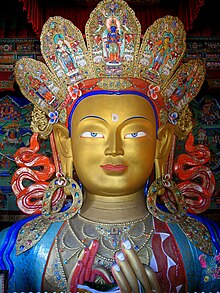
भारत हे हिंदू, बौद्ध, जैन व शीख या धर्मांचे जन्मस्थान आहे.[१] आज हिंदू धर्म व बौद्ध धर्म हे जगातील अनुक्रमे तिसऱ्या व चौथ्या क्रमांकाचे धर्म असून या दोन्ही धर्मांचे एकत्रित सुमारे १.५ अब्ज अनुयायी आहेत.[२] दुसऱ्या अनुमानानुसार बौद्ध धर्म व हिंदू धर्म हे जगातील अनुक्रमे दुसऱ्या व चौथ्या क्रमाकांचे धर्म असून या धर्मांची एकत्रित लोकसंख्या ही २.६ ते २.९ अब्ज आहे. काही अत्यंत गहन आध्यात्मिक समूह आणि संस्कृती आहेत अशा धार्मिक बाबतीत अत्यंत वैविध्यशील असणाऱ्या जगातील देशांपैकी भारत एक आहे. देशात बहुसंख्य लोकांच्या जीवनात धर्माची मध्यवर्ती व निश्चित अशी भूमिका आजही आहे. भारतात सुमारे ८०% लोकांचा धर्म हा हिंदू आहे आणि सुमारे १४% लोक इस्लामधर्मीय आहेत[३] भारतात ०.४% जैन धर्म, १.५% शीख धर्मीय आहेत. विशेषतः भारतात १% ते ६% असलेला बौद्ध धर्म हा भारतातच नव्हे तर जगभरात प्रभावशाली आहे. भारतात ख्रिश्चन धर्मीयांची संख्या २.३% असून पारशी धर्म, ज्यू धर्म आणि बहाई हेही प्रभावी आहेत पण या धर्मीयांची संख्या कमी आहे. भारतीय जीवनप्रवाहात धर्मांची भूमिका प्रबळ असली तरी सहिष्णुतेसह बाळगलेला निरीश्वरवादी किंवा ईश्वराविषयी अनास्था असलेले नास्तिक आणि निधर्मी लोक ३० लाखापेक्षा अधिक भारतात आहेत.
समाज व्यवस्था
सिंहावलोकन
यूजीन एम. मेकर याच्या मते पारंपरिक भारतीय संस्कृती ही दृढ सामाजिक उतरंडीने अधिरूपित केली आहे. मुलांना समाजातले त्यांचे स्थान आणि भूमिका यांची आठवण अगदी लहानपणापासून दिली जाते हे त्यांनी नमूद केले आहे.मेकर च्या मते,पारंपारिक भारतीय संस्कृतीला कठोर सामाजिक स्थरांनी वर्णिले जाऊ शकते. He also mentions that from an early age, children are reminded of their roles and places in society.[४] This is reinforced by the fact that many believe gods and spirits have integral and functional role in determining their life.[४] Several differences such as religion divide culture.[४] However, far more powerful division is the traditional Hindu bifurcation into non-polluting and polluting occupations.[४] Strict social taboos have governed these groups for thousands of years.[४] In recent years, particularly in cities, some of these lines have blurred and sometimes even disappeared.[४] Nuclear family is becoming central to Indian culture. Important family relations extend to as far as gotra, the mainly patrilinear lineage or clan assigned to a Hindu at birth.[४] In rural areas it is common that three or four generations of the family live under the same roof.[४] Patriarch often resolves family issues.[४]
Among developing countries, India has low levels of occupational and geographic mobility. People choose same occupations as their parents and rarely move geographically in the society.[५] During the nationalist movement, pretentious behavior was something to be avoided. Egalitarian behaviour and social service were promoted while nonessential spending was disliked and spending money for ‘showing off’ was deemed a vice. This image continues in politics with many politicians wearing simple looking / traditionally rural clothes.
कुटुंब
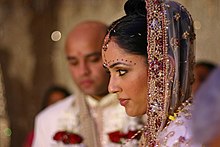
Family plays a big role in the indian culture. India for ages has had a prevailing tradition of the joint family system. It’s a system under which even extended members of a family like one’s parents, children, the children’s spouses and their offspring, etc. live together. The elder-most, usually the male member is the head in the joint Indian family system who makes all important decisions and rules, whereas other family members abide by it.
Arranged marriages have the tradition in Indian society for centuries. Even today, overwhelming majority of Indians have their marriages planned by their parents and other respected family-members, with the consent of the bride and groom.[६] Arranged matches were made after taking into account factors such as age, height, personal values and tastes, the backgrounds of their families (wealth, social standing) and their castes and the astrological compatibility of the couples' horoscopes.
In India, the marriage is thought to be for life[७], and the divorce rate is extremely low — 1.1% compared with about 50% in the United States.[८] The arranged marriages generally have a much lower divorce rate. The divorce rates have risen significantly in recent years:
- "Opinion is divided over what the phenomenon means: for traditionalists the rising numbers portend the breakdown of society while, for some modernists, they speak of a healthy new empowerment for women."[९]
Although child marriage was outlawed in 1860, it is continued to be practiced in some rural parts of India.[१०] According to UNICEF’s “State of the World’s Children-2009” report, 47% of India's women aged 20–24 were married before the legal age of 18, with 56% in rural areas.[११] The report also showed that 40% of the world's child marriages occur in India.[१२]
Indian names are based on a variety of systems and naming conventions, which vary from region to region. Names are also influenced by religion and caste and may come from religion or epics. India's population speaks a wide variety of languages.
Although women and men are equal before the law and the trend toward gender equality has been noticeable, women and men still occupy distinct functions in Indian society.Woman's role in the society is often to perform household works and pro bono community work[४]. This low rate of participation has ideological and historical reasons. Women and women's issues appear only 7-14% of the time in news programs.[४] In most Indian families, women do not own any property in their own names, and do not get a share of parental property.[१३] Due to weak enforcement of laws protecting them, women continue to have little access to land and property.[१४] In many families, especially rural ones, the girls and women face nutritional discrimination within the family, and are anaemic and malnourished.[१३] They still lag behind men in terms of income and job status. Traditional Hindu art, such as Rangoli (or Kolam), is very popular among Indian women. Popular and influential woman's magazines include Femina, Grihshobha and Woman's Era.
प्राणी

The varied and rich wildlife of India has had a profound impact on the region's popular culture. Common name for wilderness in India is Jungle which was adopted by the British colonialists to the English language. The word has been also made famous in The Jungle Book by Rudyard Kipling. India's wildlife has been the subject of numerous other tales and fables such as the Panchatantra and the Jataka tales.[१५]
In Hinduism, the cow is regarded as a symbol of ahimsa (non-violence), mother goddess and bringer of good fortune and wealth.[१६] For this reason, cows are revered in Hindu culture and feeding a cow is seen as an act of worship.[१७]
नमस्ते
Namaste, Namaskar or Namaskara is a common spoken greeting or salutation in the Indian subcontinent. Namaskar is considered a slightly more formal version than namaste but both express deep respect. It is commonly used in India and Nepal by Hindus, Jains and Buddhists, and many continue to use this outside the Indian subcontinent. In Indian and Nepali culture, the word is spoken at the beginning of written or verbal communication. However, the same hands folded gesture is made usually wordlessly upon departure. In yoga, namaste is said to mean "The light in me honors the light in you," as spoken by both the yoga instructor and yoga students.
Taken literally, it means "I bow to you". The word is derived from Sanskrit (namas): to bow, obeisance, reverential salutation, and respectand (te): "to you".
When spoken to another person, it is commonly accompanied by a slight bow made with hands pressed together, palms touching and fingers pointed upwards, in front of the chest. The gesture can also be performed wordlessly or calling on another god Eg: "Jai shri Krishna" and carry the same meaning.

सण
India, being a multi-cultural and multi-religious society, celebrates holidays and festivals of various religions. The three national holidays in India, the Independence Day, the Republic Day and the Gandhi Jayanti, are celebrated with zeal and enthusiasm across India. In addition, many states and regions have local festivals depending on prevalent religious and linguistic demographics. Popular religious festivals include the Hindu festivals of Navratri Diwali, Ganesh Chaturthi, Durga puja, Holi, Rakshabandhan and Dussehra. Several harvest festivals, such as Sankranthi, Pongal and Onam,"Nuakhai" are also fairly popular. Certain festivals in India are celebrated by multiple religions. Notable examples include Diwali which celebrated by Hindus, Sikhs and Jains and Buddh Purnima which is celebrated by Buddhists and Hindus. Islamic festivals, such Eid ul-Fitr, Eid al-Adha and Ramadan, are celebrated by Muslims across India. Adding colors to the culture of India, the Dree Festival is one of the tribal festivals of India celebrated by the Apatanis of the Ziro valley of Arunachal Pradesh, which is the easternmost state of this country.
पाक कला

The multiple families of Indian cuisine are characterized by their sophisticated and subtle use of many spices and herbs. Each family of this cuisine is characterized by a wide assortment of dishes and cooking techniques. Though a significant portion of Indian food is vegetarian, many traditional Indian dishes also include chicken, goat, lamb, fish, and other meats.
Food is an important part of Indian culture, playing a role in everyday life as well as in festivals. Indian cuisine varies from region to region, reflecting the varied demographics of the ethnically diverse subcontinent. Generally, Indian cuisine can be split into five categories: North, South, East,West Indian and North-eastern India.
Despite this diversity, some unifying threads emerge. Varied uses of spices are an integral part of food preparation, and are used to enhance the flavor of a dish and create unique flavors and aromas. Cuisine across India has also been influenced by various cultural groups that entered India throughout history, such as the Persians, Mughals, and European colonists. Though the tandoor originated in Central Asia, Indian tandoori dishes, such as chicken tikka made with Indian ingredients, enjoy widespread popularity.[१८]
Indian cuisine is one of the most popular cuisines across the globe.[१९] Historically, Indian spices and herbs were one of the most sought after trade commodities. The spice trade between India and Europe led to the rise and dominance of Arab traders to such an extent that European explorers, such as Vasco da Gama and Christopher Columbus, set out to find new trade routes with India leading to the Age of Discovery.[२०] The popularity of curry, which originated in India, across Asia has often led to the dish being labeled as the "pan-Asian" dish.[२१]
पोषाख

Traditional Indian clothing for women are the saris and also Ghaghra Cholis (Lehengas). For men, traditional clothes are the Dhoti/pancha/veshti or Kurta. दिल्ली is considered to be India's fashion capital, housing the annual Fashion weeks. In some village parts of India, traditional clothing mostly will be worn. दिल्ली, मुंबई, चेन्नई, Ahmedabad, and पुणे are all places for people who like to shop. In southern India the men wear long, white sheets of cloth called dhoti in English and in Tamil. Over the dhoti, men wear shirts, t-shirts, or anything else. Women wear a sari, a long sheet of colourful cloth with patterns. This is draped over a simple or fancy blouse. This is worn by young ladies and woman. Little girls wear a pavada. A pavada is a long skirt worn under a blouse. Both are often gaily patterned. Bindi is part of the women's make-up. Traditionally, the red bindi (or sindhur) was worn only by the married Hindu women, but now it has become a part of women's fashion. A bindi is also worn by some as their third eye. It sees what the others eyes can't and protect your brain from the outside and the sun.[२२] Indo-western clothing is the fusion of Western and Subcontinental fashion. Churidar, Dupatta, Gamchha, Kurta, Mundum Neriyathum, Sherwani, uttariya are among other clothes.
वाड्मय
इतिहास
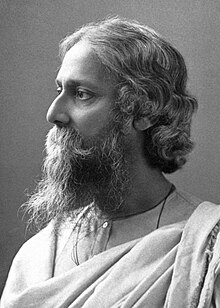
The earliest works of Indian literature were orally transmitted. Tamil literature begins with the sangam literature a collection of sacred hymns dating to the period 10000BC–1200 BCE. The tamil epics tolkappiyam and thirukural appeared towards the end of the first millennium BCE. Classical Tamil literature succeeded well in the first few centuries of the first millennium CE.
In the medieval period, literature in Kannada and Telugu appears in the 9th and 11th centuries respectively,[२४] followed by the first Malayalam works in the 12th century. During this time, literature in the Tamil, Bengali, Marathi, and various dialects of Hindi, and उर्दू भाषा began to appear as well.
Some of the most important authors from India are Rabindranath Tagore, Ramdhari Singh 'Dinkar', Subramania Barathi, Kuvempu, Bankim Chandra Chattopadhyay, Michael Madhusudan Dutt, Munshi Premchand, Muhammad Iqbal, Devaki Nandan Khatri became well known. In contemporary India, among the writers who have received critical acclaim are: Girish Karnad, Agyeya, Nirmal Verma, Kamleshwar, Vaikom Muhammad Basheer, Indira Goswami, Mahasweta Devi, Amrita Pritam, Maasti Venkatesh Ayengar, Qurratulain Hyder and Thakazhi Sivasankara Pillai and others have received critical acclaim.
In contemporary Indian literature, there are two major literary awards; these are the Sahitya Akademi Fellowship and the Jnanpith Award. Seven Jnanpith awards each have been awarded in Kannada, six in Hindi, five in Bengali, four in Malayalam, three each in and Marathi, Gujarati, उर्दू भाषा and Oriya.[२५]
काविता
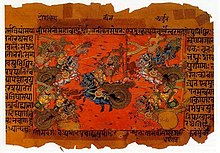
India has strong traditions of poetry ever since the Rigveda, as well as prose compositions. Poetry is often closely related to musical traditions, and much of poetry can be attributed to religious movements. Writers and philosophers were often also skilled poets. In modern times, poetry has served as an important non-violent tool of nationalism during the Indian freedom movement. A famous modern example of this tradition can be found in such figures as Rabindranath Tagore, Kuvempu and K. S. Narasimhaswamy in modern times and poets such as Basava (vachanas) , Kabir and Purandaradasa (padas and devaranamas) in medieval times, as well as the epics of ancient times. Two examples of poetry from Tagore's Gitanjali serve as the national anthems of both India and Bangladesh.
महाकाव्ये
The Ramayana and Mahabharata are the oldest preserved and still well-known epics of India; some of their versions have been adopted as the epics of Southeast Asian countries like Thailand, Malaysia and Indonesia. In addition, there are five epics in the classical Tamil language are Silappadhikaram, Manimegalai, Civaka Cintamani, Tirutakkatevar, Kundalakesi.
Other regional variations of them as well as unrelated epics include the Tamil Kamba Ramayanam, in Kannada, the Pampa Bharata by Adikavi Pampa, Torave Ramayana by Kumara Valmiki and Karnata Bharata Katha Manjari by Kumaravyasa, Hindi Ramacharitamanasa, Malayalam Adhyathmaramayanam.
कला प्रस्तुती
संगीत

The music of India includes multiples varieties of religious, folk, popular, pop, and classical music. The oldest preserved examples of Indian music are the melodies of the Samaveda that are still sung in certain Vedic Śrauta sacrifices. India's classical music tradition is heavily influenced by Hindu texts. It includes two distinct styles: Carnatic and Hindustani music. It is noted for the use of several Raga, melodic modes. it has a history spanning millennia and it was developed over several eras. It remains instrumental to the religious inspiration, cultural expression and pure entertainment.
Purandaradasa is considered the "father of carnatic music" (Karnataka sangeeta pitamaha).[२६][२७][२८] He concluded his songs with a salutation to Lord Purandara Vittala and is believed to have composed as many as 475,000[२९] songs in the Kannada language. However, only about 1000 are known today.[२६][३०]
नृत्य
Indian dance too has diverse folk and classical forms. Among the well-known folk dances are the bhangra of the Punjab, the bihu of Assam, the chhau of Jharkhand and Orissa, the ghoomar of Rajasthan, the dandiya and garba of Gujarat, the Yakshagana of Karnataka and lavani of महाराष्ट्र and Dekhnni of Goa. Eight dance forms, many with narrative forms and mythological elements, have been accorded classical dance status by India's National Academy of Music, Dance, and Drama. These are: bharatanatyam of the state of Tamil Nadu, kathak of Uttar Pradesh, kathakali and mohiniattam of Kerala, kuchipudi of Andhra Pradesh, manipuri of Manipur, odissi of the state of Orissa and the sattriya of Assam.[३१][३२]
Kalarippayattu or Kalari for short is considered one of the world's oldest martial art. It is preserved in texts such as the Mallapurana. Kalari and other later formed martial arts have been assumed by some to have traveled to China, like Buddhism, and eventually developing into Kung-fu. Other later martial arts are Gatka, Pehlwani and Malla-yuddha. There have been many great prout
नाट्य आणि नाट्यगृह

Indian drama and theater has a long history alongside its music and dance. Kalidasa's plays like Shakuntala and Meghadoota are some of the older plays, following those of Bhasa. One of the oldest surviving theatre tradition of the world is the 2000 year old Kutiyattam of Kerala. It strictly follows the Natya Shastra[३३]. The natak of Bhasa are very popular in this art form. Nātyāchārya (late) Padma Shri Māni Mādhava Chākyār- the unrivaled maestro of this art form and Abhinaya, revived the age old drama tradition from extinction. He was known for mastery of Rasa Abhinaya. He started to perform the Kalidasa plays like Abhijñānaśākuntala, Vikramorvaśīya and Mālavikāgnimitra; Bhasa's Swapnavāsavadatta and Pancharātra; Harsha's Nagananda in Kutiyattam form[३४][३५]
The tradition of folk theater is popular in most linguistic regions of India. In addition, there is a rich tradition of puppet theater in rural India, going back to at least the second century BCE. (It is mentioned in Patanjali's commentary on Panini). Group Theater is also thriving in the cities, initiated by the likes of Gubbi Veeranna,[३६] Utpal Dutt, Khwaja Ahmad Abbas, K. V. Subbanna and still maintained by groups like Nandikar, Ninasam and Prithvi Theatre.
दृश्य कला
चित्रकला

The earliest Indian paintings were the rock paintings of pre-historic times, the petroglyphs as found in places like Bhimbetka, some of which go back to the Stone Age. Ancient texts outline theories of darragh and anecdotal accounts suggesting that it was common for households to paint their doorways or indoor rooms where guests resided.
Cave paintings from Ajanta, Bagh, Ellora and Sittanavasal and temple paintings testify to a love of naturalism. Most early and medieval art in India is Hindu, Buddhist or Jain. A freshly made coloured flour design (Rangoli) is still a common sight outside the doorstep of many (mostly South Indian) Indian homes. Raja Ravi Varma is one the classical painters from medieval India.
Madhubani painting, Mysore painting, Rajput painting, Tanjore painting, Mughal painting are some notable Genres of Indian Art; while Nandalal Bose, M. F. Husain, S. H. Raza, Geeta Vadhera, Jamini Roy and B.Venkatappa[३७] are some modern painters. Among the present day artists, Atul Dodiya, Bose Krishnamacnahri, Devajyoti Ray and Shibu Natesan represent a new era of Indian art where global art shows direct amalgamation with Indian classical styles. These recent artists have acquired international recognition. Jehangir Art Gallery, मुंबई, Mysore Palace has on display a few good Indian paintings.
शिल्प

The first sculptures in India date back to the Indus Valley civilization, where stone and bronze figures have been discovered. Later, as Hinduism, Buddhism, and Jainism developed further, India produced some extremely intricate bronzes as well as temple carvings. Some huge shrines, such as the one at Ellora were not constructed by using blocks but carved out of solid rock.
Sculptures produced in the northwest, in stucco, schist, or clay, display a very strong blend of Indian and Classical Hellenistic or possibly even Greco-Roman influence. The pink sandstone sculptures of Mathura evolved almost simultaneously. During the Gupta period (4th to 6th century) sculpture reached a very high standard in execution and delicacy in modeling. These styles and others elsewhere in India evolved leading to classical Indian art that contributed to Buddhist and Hindu sculpture throughout Southeast Central and East Asia.
वास्तूशास्त्र
Indian architecture encompasses a multitude of expressions over space and time, constantly absorbing new ideas. The result is an evolving range of architectural production that nonetheless retains a certain amount of continuity across history. Some of its earliest production are found in the Indus Valley Civilization (2600-1900 BCE) which is characterised by well planned cities and houses. Religion and kingship do not seem to have played an important role in the planning and layout of these towns.
During the period of the Maurya and Gupta empires and their successors, several Buddhist architectural complexes, such as the caves of Ajanta and Ellora and the monumental Sanchi Stupa were built. Later on, South India produced several Hindu temples like Chennakesava Temple at Belur, the Hoysaleswara Temple at Halebidu, and the Kesava Temple at Somanathapura, Brihadeeswara Temple, Thanjavur, the Sun Temple, Konark, Sri Ranganathaswamy Temple at Srirangam, and the Buddha stupa (Chinna Lanja dibba and Vikramarka kota dibba) at Bhattiprolu. Angkor Wat, Borobudur and other Buddhist and Hindu temples indicate strong Indian influence on South East Asian architecture, as they are built in styles almost identical to traditional Indian religious buildings.
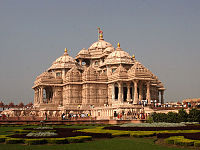
The traditional system of Vaastu Shastra serves as India's version of Feng Shui, influencing town planning, architecture, and ergonomics. It is unclear which system is older, but they contain certain similarities. Feng Shui is more commonly used throughout the world. Though Vastu is conceptually similar to Feng Shui in that it also tries to harmonize the flow of energy, (also called life-force or Prana in Sanskrit and Chi/Ki in Chinese/Japanese), through the house, it differs in the details, such as the exact directions in which various objects, rooms, materials, etc. are to be placed.
With the advent of Islamic influence from the west, Indian architecture was adapted to allow the traditions of the new religion. Fatehpur Sikri, Taj Mahal, Gol Gumbaz, Qutub Minar, Red Fort of Delhi are creations of this era, and are often used as the stereotypical symbols of India. The colonial rule of the British Empire saw the development of Indo-Saracenic style, and mixing of several other styles, such as European Gothic. The Victoria Memorial or the Victoria Terminus are notable examples.
Indian architecture has influenced eastern and southeastern Asia, due to the spread of Buddhism. A number of Indian architectural features such as the temple mound or stupa, temple spire or sikhara, temple tower or pagoda and temple gate or torana, have become famous symbols of Asian culture, used extensively in East Asia and South East Asia. The central spire is also sometimes called a vimanam. The southern temple gate, or gopuram is noted for its intricacy and majesty.
Contemporary Indian architecture is more cosmopolitan. Cities are extremely compact and densely populated. Mumbai's Nariman Point is famous for its Art Deco buildings. Recent creations such as the Lotus Temple, and the various modern urban developments of India like Chandigarh, are notable.
करमणुक व खेळ

In the area of recreation and sports India had evolved a number of games. The modern eastern martial arts originated as ancient games and martial arts in India, and it is believed by some that these games were transmitted to foreign countries, where they were further adapted and modernized. Traditional indigenous sports include kabaddi and gilli-danda, which are played in most parts of the country.
A few games introduced during the British Raj have grown quite popular in India: field hockey, football (soccer) and especially cricket. Although field hockey is India's official national sport, cricket is by far the most popular sport not only in India, but the entire subcontinent, thriving recreationally and professionally. Cricket has even been used recently as a forum for diplomatic relations between India and Pakistan. The two nations' cricket teams face off annually and such contests are quite impassioned on both sides. Polo is also popular.
Indoor and outdoor games like Chess, Snakes and Ladders, Playing cards, Carrom, Badminton are popular. Chess was invented in India.
Games of strength and speed flourished in India. In ancient India stones were used for weights, marbles, and dice. Ancient Indians competed in chariot racing, archery, horsemanship, military tactics, wrestling, weight lifting, hunting, swimming and running races.
प्रसिद्ध माध्यमे
दूरदर्शन
Indian television started off in 1959 in New Delhi with tests for educational telecasts.[३९] Indian small screen programming started off in the mid 1970s. At that time there was only one national channel Doordarshan, which was government owned. 1982 saw revolution in TV programming in India, with the New Delhi Asian games, India saw the colour version of TV, that year. The Ramayana and Mahabharat were some among the popular television series produced. By the late 1980s more and more people started to own television sets. Though there was a single channel, television programming had reached saturation. Hence the government opened up another channel which had part national programming and part regional. This channel was known as DD 2 later DD Metro. Both channels were broadcasted terrestrially.
In 1991, the government liberated its markets, opening them up to cable television. Since then, there has been a spurt in the number of channels available. Today, Indian silver screen is a huge industry by itself, and has thousands of programmes in all the states of India. The small screen has produced numerous celebrities of their own kind some even attaining national fame for themselves. TV soaps are extremely popular with housewives as well as working women, and even men of all kinds. Some small time actors have made it big in Bollywood. Indian TV now has many of the same channels as Western TV, including stations such as Cartoon Network, Nickelodeon, and MTV India.
चित्रपट
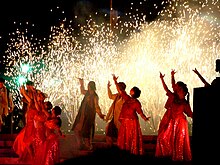
Bollywood is the informal name given to the popular मुंबई-based film industry in India. Bollywood and the other major cinematic hubs (in Bengali, Kannada, Malayalam, Marathi, Tamil, Punjabi and Telugu) constitute the broader Indian film industry, whose output is considered to be the largest in the world in terms of number of films produced and number of tickets sold.
India has produced many critically acclaimed cinema-makers like सत्यजित राय, ऋत्विक घटक, गुरू दत्त, के. विश्वनाथ, अडूर गोपालकृष्णन, गिरीश कासारवल्ली, शेखर कपूर, हृषिकेश मुखर्जी, शंकर नाग, गिरीश कर्नाड, जी.व्ही. अैयर, etc. (See Indian film directors). With the opening up of the economy in the recent years and consequent exposure to world cinema, audience tastes have been changing. In addition, multiplexes have mushroomed in most cities, changing the revenue patterns.
हेसुद्धा पहा
संदर्भ
http://santeknath.org/vagmayavishayi.html
- ^ Outsourcing to India By Mark Kobayashi-Hillary
- ^ Finding Lost - By Nikki Stafford
- ^ (PDF) http://www.censusindia.net/religiondata/Summary%20Muslims.pdf. 2006-06-01 रोजी पाहिले. Missing or empty
|title=(सहाय्य) - ^ a b c d e f g h i j k Eugene M. Makar. Missing or empty
|title=(सहाय्य) - ^ Kaivan Munshi and Mark Rosenzweig. (PDF) http://www.econ.yale.edu/seminars/labor/lap05-06/Rosenzweig091605.pdf. Missing or empty
|title=(सहाय्य) - ^ http://www.jamaica-gleaner.com/gleaner/20050215/life/life1.html Love vs arranged marriages, Keisha Shakespeare
- ^ http://www.thepost.co.za/index.php?fSectionId=154&fArticleId=2613258
- ^ http://www.divorcerate.org/divorce-rate-in-india.html Divorce Rate In India
- ^ http://www.telegraph.co.uk/news/worldnews/asia/india/1499679/Divorce-soars-in-India's-middle-class.html Divorce soars in India's middle class
- ^ BBC News | SOUTH ASIA | Child marriages targeted in India
- ^ http://www.unicef.org/sowc09/docs/SOWC09_Table_9.pdf
- ^ http://www.hindu.com/2009/01/18/stories/2009011855981100.htm
- ^ a b Kalyani Menon-Sen, A. K. Shiva Kumar. http://www.un.org.in/wii.htm. 2006-12-24 रोजी पाहिले. Missing or empty
|title=(सहाय्य) - ^ Carol S. Coonrod. http://www.thp.org/reports/indiawom.htm. 2006-12-24 रोजी पाहिले. Unknown parameter
|month=ignored (सहाय्य); Missing or empty|title=(सहाय्य) - ^ Symbolism in Indian culture
- ^ South Asian folklore - By Peter J. Claus, Sarah Diamond, Margaret Ann Mills
- ^ Nature's web - By Peter H. Marshall
- ^ http://www.asiarooms.com/travel-guide/australia/brisbane/what-where-to-eat/indian-restaurants-in-brisbane/tandoori-village-restaurant-brisbane.html. Missing or empty
|title=(सहाय्य) - ^ http://www.accessmylibrary.com/coms2/summary_0286-19130531_ITM. Missing or empty
|title=(सहाय्य) - ^ Louise Marie M. Cornillez. http://www.english.emory.edu/Bahri/Spice_Trade.html. Missing or empty
|title=(सहाय्य) - ^ http://www.meatlessmonday.com/site/PageServer?pagename=dyk_curry. Missing or empty
|title=(सहाय्य) - ^ Kamat's Potpourri: The Significance of the holy dot (Bindi)
- ^ http://almaz.com/nobel/literature/1913a.html
- ^ "Kannada literature," Encyclopaedia Britannica, 2008. Quote: "The earliest literary work is the Kavirajamarga (c. AD 850), a treatise on poetics based on a Sanskrit model."
- ^ "Narayan, Kelkar and Shastri chosen for Jnanpith award", All India Radio, November 22, 2008.
- ^ a b Dr. Jytosna Kamat. http://www.kamat.com/kalranga/kar/literature/dasa.htm. 2006-12-31 रोजी पाहिले. Missing or empty
|title=(सहाय्य) - ^ Madhusudana Rao CR. http://www.dvaita.org/haridasa/dasas/purandara/purandara.html. 2006-12-31 रोजी पाहिले. Missing or empty
|title=(सहाय्य) - ^ S. Sowmya, K. N. Shashikiran. http://carnatica.net/origin.htm. 2006-12-31 रोजी पाहिले. Missing or empty
|title=(सहाय्य) - ^ http://www.dvaita.org/haridasa/dasas/purandara/p_dasa1.html
- ^ Madhusudana Rao CR. http://www.dvaita.org/haridasa/dasas/purandara/p_dasa1.html. 2006-12-31 रोजी पाहिले. Missing or empty
|title=(सहाय्य) - ^ "South Asian arts: Techniques and Types of Classical Dance"
- ^ "Indian Dance Videos: Bharatanatyam, Kathak, Bhangra, Garba, Bollywood and various folk dances"
- ^ Māni Mādhava Chākyār. Missing or empty
|title=(सहाय्य)p.6 - ^ K. A. Chandrahasan, In pursuit of excellence (Performing Arts), "The Hindu", Sunday March 26, 1989
- ^ Mani Madhava Chakkyar: The Master at Work (film- English), Kavalam N. Panikar, Sangeet Natak Akademi, New Delhi, 1994
- ^ Kamath (2003), p282
- ^ Kamath (2003), p283
- ^ Umaid Bhawan Palace, Famous Palace Stay at Umaid Bhawan in Jodhpur, Famous Palace Attractions in Jodhpur
- ^ http://www.indiantelevision.com/indianbrodcast/history/historyoftele.htm. 2006-06-01 रोजी पाहिले. Missing or empty
|title=(सहाय्य)
अधीक वाचन
- Nilakanta Sastri, K.A. New Delhi. Unknown parameter
|मूळवर्ष=ignored (सहाय्य); Missing or empty|title=(सहाय्य) - Narasimhacharya, R. New Delhi, Madras. Unknown parameter
|मूळवर्ष=ignored (सहाय्य); Missing or empty|title=(सहाय्य) - Rice, B.L. New Delhi, Madras. Unknown parameter
|मूळवर्ष=ignored (सहाय्य); Missing or empty|title=(सहाय्य) - Kamath, Suryanath U. Bangalore. Unknown parameter
|ओसीएलसी=ignored (सहाय्य); Unknown parameter|आयडी=ignored (सहाय्य); Unknown parameter|मूळवर्ष=ignored (सहाय्य); Missing or empty|title=(सहाय्य) - Varma, Pavan K. Being Indian: Inside the Real India. (ISBN 0-434-01391-9)
- Tully, Mark. No Full Stops in India. (ISBN 0-14-010480-1)
- Naipaul, V.S. India: A Million Mutinies Now. (ISBN 0-7493-9920-1)
- Grihault, Nicki. India - Culture Smart!: a quick guide to customs and etiquette. (ISBN 1-85733-305-5)
- Manjari Uil, Foreign Influence on Indian Culture (c.600 BC to AD 320), (ISBN 81-88629-60-X)
बाह्य दुवे
- Indian Govt. Site devoted to preserving manuscripts and making them available
- Treasure House of India's Art and Culture
- IndianCultureOnline.com - Indian Culture Photos+Detail Information
- Culture Coverage
- An Introduction to Indian Culture
लेखात प्रयुक्त संज्ञा
शब्दाचा विशेष संदर्भ/अर्थ छटा
| प्रयूक्त शब्द | विशेष संदर्भ/अर्थ छटा |
| 3 | 4 |
इंग्रजी मराठी संज्ञा
| इंग्रजी | मराठी |
| Overview | सिंहावलोकन |
| theatre | नाट्यगृह |
| Popular | प्रसिद्ध |
| Bollywood | मराठी |
| Performing Arts | कला प्रस्तुती |
